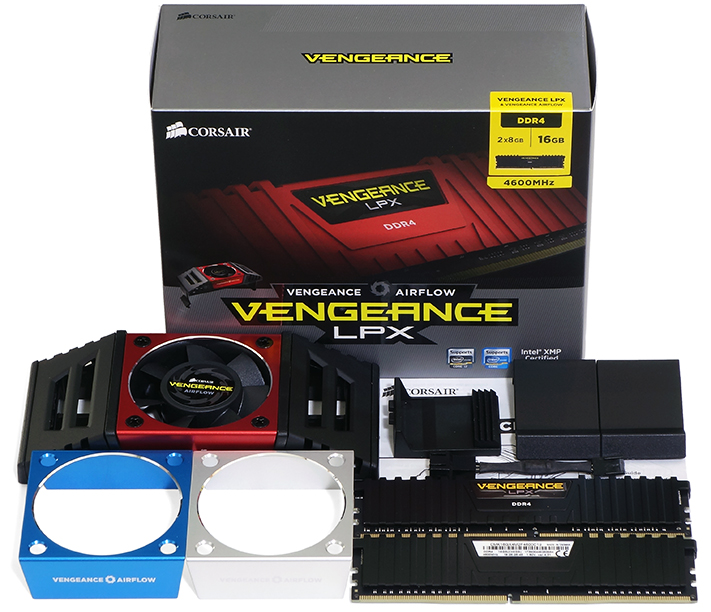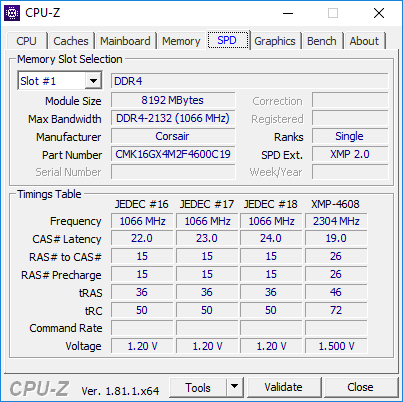Early Verdict
Anyone who refuses to be one-upped in the battle for ultimate data rate will want to jump at their first chance to buy Corsair’s Vengeance LPX DDR4-4600. Everyone else will probably want to consider other optimizations.
Pros
- +
Superb DDR4-4600 rating
- +
Includes cooling fan
- +
Lifetime warranty in spite of high voltage requirement
Cons
- -
High voltage requirement
- -
Requires exceptionally stable motherboard and CPU
- -
High price
Why you can trust Tom's Hardware
Features & Specifications
Famous for extravagant features, Corsair gets back to the basics with its Vengeance LPX series. That is, if your definition of the basics is to strip out whatever doesn’t make a product faster. Vengeance LPX doesn’t have RGB or old-school activity lights that made Corsair famous with the case mod crowd, but it does include the firm’s old-school fan and red/blue/silver trim kit.
The modules themselves are covered in nothing more than stamped aluminum heat spreaders, lacking any of the fancy heat pipes and electrical connectors that Corsair once used to monitor heat and adjust fans externally.
Specifications
And talk about kicking it old school, these DDR4-4600 modules require DDR3-level voltages simply to get to their rated data rate and timings. If you thought the 1.35V signal limit to Intel’s memory controller has been in place since Skylake, you’d be mostly right.
Intel’s stated voltage limit was intended to reduce the component degradation (such as electromigration) that occurs more quickly as components are shrunk or the voltage difference is increased, but overclockers found that increasing the memory controller voltage allowed them to likewise increase DIMM voltage without overstressing the memory controller. User forums were tossing around the notion that the difference between the memory controller and DIMM signal should be no more than 150mV, and it turns out that certain motherboards will respond to a high DIMM voltage by increasing that of the memory controller. That’s just one of several things Corsair likely considers when recommending a board from which to evaluate its 1.50V DDR4.
Apart from the CPU core voltage that we set, the voltage levels pictured above are how this motherboard responded to the 1.50V requirement of Corsair’s DDR4-4600 XMP. Other optimizations for testing memory of such high data rate were that the CPU be nearly perfect, that the motherboard have only one slot per channel (to reduce possible noise), and that the pathways connecting that slot to the CPU be both short and well optimized. The motherboard is MSI’s recently reviewed Z370I Gaming Pro Carbon AC.
We moved straight from our Z370I Gaming Pro Carbon AC review to this Vengeance LPX DDR4-4600 evaluation, leaving the fixed 4.80 GHz CPU clock at 1.30V in place. The entire test configuration can be seen in our Z370I Gaming Pro Carbon AC Review. Comparison modules were chosen for a specific purpose: G.Skill’s DDR4-3866 and Super Talent’s DDR4-3733 for their high data rates, and Super Talent’s DDR4-3000 for its dual-rank organization. Yes, single-vs-dual rank is still a compelling performance factor.
Comparison Products




The G.Skill modules are readily available at a middling price, but the Project X DDR4-3733 can only be ordered directly from Super Talent’s distributor, Ma Labs, by those who have set up an account. Meanwhile, its F3000UX16G can be found “on the street,” but only by purchasing two of the individual F3000UB8G modules that comprise this dual-channel kit.
Get Tom's Hardware's best news and in-depth reviews, straight to your inbox.
MORE: Best Memory
MORE: DDR DRAM FAQs And Troubleshooting Guide
MORE: All Memory Content
-
barryv88 Ok correct me if I'm wrong, but it seems that the Super Talent F3200 kit smokes everything in terms of overall performance and at the same time, costs only 129 bucks. Seems like a bargain to me.Reply -
none12345 Am i missing something? The cheapest and lowest rated ram of the comparison is the fastest?Reply
Why even sell 4600 if its slower then 3200. -
Wisecracker Reply
I would urge caution in sweeping generalizations (in a limited 'Corsair' review) while noting the F3000UX16G first numbers are impressive in this instance.20668211 said:Ok correct me if I'm wrong, but it seems that the Super Talent F3200 kit smokes everything in terms of overall performance and at the same time, costs only 129 bucks. Seems like a bargain to me.
I'll also note that the F3000UX16G kit is the only (?) dual-rank set, and a DDG search did not find any in stock -- and where listed were priced from $186 to $200.
That said, here's hoping the fine folks at THG can pull together the AM4+ components for a test-drive of a new RyZen APU at similar levels. Make it so, Corsair!
-
alex0826 $549 for 16 gigs of ddr4 RAM, granted it's high-speed Ram, but really? Who's drug habits are we supporting? They are out of their tree, not to mention the cost of a 1950x CPU and a $400 motherboard to go with it, wow! And this Hardware combined is not even a fraction of a Quantum computer. Of course we're talking about two different leagues but still I had to throw in that stupid analogy. What I'm trying to say is mainstream consumer PC Hardware whether it be enthusiastic class or not seems to be getting pricier over the recent years. Yuck! I think companies and manufacturers alike should all get on the same page and keep their prices really low. That way consumers will have a connection fit and name their first born after that company LOL. Mainly I'm complaining because I can't afford to build the threadripper rig I would surely like to build to replace the FX 9590 I've had for a number of years.:-(Reply -
alex0826 There should be an option to edit what you've posted like other forms allow. I said conniption fit but something else came out LOLReply -
panathas Reply20668688 said:There should be an option to edit what you've posted like other forms allow. I said conniption fit but something else came out LOL
All comments can be edited. You just need to get to the forums in order to do it. Click the COMMENT FROM THE FORUMS link in the upper right part of the comments section. -
Crashman Reply
We originally presented Super Talent's dual-rank DIMMs as an alternative to the T-Force Dark ROG memory reviewed here:20668548 said:
I would urge caution in sweeping generalizations (in a limited 'Corsair' review) while noting the F3000UX16G first numbers are impressive in this instance.20668211 said:Ok correct me if I'm wrong, but it seems that the Super Talent F3200 kit smokes everything in terms of overall performance and at the same time, costs only 129 bucks. Seems like a bargain to me.
I'll also note that the F3000UX16G kit is the only (?) dual-rank set, and a DDG search did not find any in stock -- and where listed were priced from $186 to $200.
That said, here's hoping the fine folks at THG can pull together the AM4+ components for a test-drive of a new RyZen APU at similar levels. Make it so, Corsair!
http://www.tomshardware.com/reviews/teamgroup-dark-rog-16gb-ddr4-3000,4997.htmlThe T-Force Dark ROG is available for $192 at Newegg.
-
jgunn2 If the DDR4-4600 Corsair RAM is advertised at 4600mhz with a requirement of 1.5V to reach this speed, why is it compared to other RAM sets only being tested at 1.30V? Am I missing something? Why was its full potential not tested vs. the full potential of the competition? Why is there no posted performance data based on the Cosair advertised specs? Kind of like buying a V6 but taking 2 cylinders out and then expecting it to perform better than a cheaper car specifically optimized as an inline 4...Reply -
Crashman Reply
First of all, it's 1.35V. Take a look at the top of this chart:20669084 said:If the DDR4-4600 Corsair RAM is advertised at 4600mhz with a requirement of 1.5V to reach this speed, why is it compared to other RAM sets only being tested at 1.30V? Am I missing something? Why was its full potential not tested vs. the full potential of the competition? Why is there no posted performance data based on the Cosair advertised specs? Kind of like buying a V6 but taking 2 cylinders out and then expecting it to perform better than a cheaper car specifically optimized as an inline 4...
We set the 1.35V test limit back when people were having trouble with memory controller damage from higher-voltage RAM. The workaround was to increase the memory controller voltage in order to reduce the voltage difference between the memory controller and the memory signal, but we never employed it. Yet some manufacturers have figured out that some motherboards will now use the workaround when configured with 1.50V RAM.
We agreed to test the kit before taking note of its test-violating voltage level. Rather than force a violation out of the other kits, we limited the 1.50V test to DDR4-4600's XMP configuration. If you look at the charts you'll see it performed better at DDR4-4000 with optimized timings than it had at DDR4-4600 using XMP timings? The DDR4-4000 test, like those of the competing modules, was run at 1.35V.








